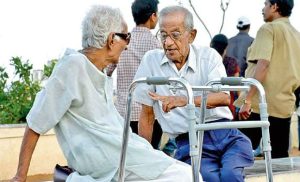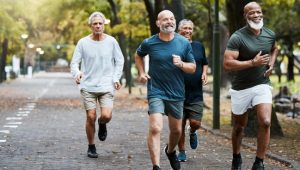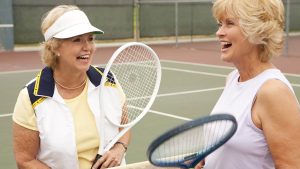6
Section One: The Fundamentals
A) Keywords
Exercise 1:
Provide a brief definition of one of the padlet keywords for this week.
| Equity. This means making things fair, not necessarily equal. It means giving opportunity to or lifting up those who do not hold power in society. It means to level out the playing field by assessing who is in need and providing the tools necessary to change that.
|
B) The Social Significance of Aging in Sport
Exercise 2: Notebook Prompt
How is old age popularly represented today? Find an image online that you think exemplifies one defining attitude towards old age and paste in your notebook below with a brief explanation of what this image means to you.
| Old age is popularly represented as someone who has become helpless or disabled in the same way. Once having reached a certain age, they are infantilized and reduced to any identity they may believe they hold.
|
Exercise 3: Notebook Prompt
What does the article (referencing another study by Dionigi) mean by its statement that sport can help aging people to simultaneously “accept and resist the ageing process” (572)? Respond by audio or text and find paste two images sourced online into your notebook showing how sport might help aging people to both accept and resist the aging process.
| The article means that sport can help older people both accept and push back against getting older. Accepting the aging process means recognizing that the body changes over time, like slower movement or less strength. Through sport, older adults can come to terms with these changes in a healthy and realistic way. At the same time, sport helps people resist negative ideas about aging. Many older adults stay active, compete, and enjoy physical challenges. This shows that being older doesn’t mean becoming weak or inactive. It challenges common stereotypes that aging always means decline or poor health. So, sport plays a double role, it helps people live with aging, but also fights the idea that aging limits what they can do. In this way, older adults can stay confident, healthy, and socially connected through sport.
|
Exercise 4: Notebook Prompt
Who are the groups less likely to have extensive opportunities to take part in sports, according to Pike? How does privilege factor into aging and sport? (200 words max)
These groups often face barriers like limited access to facilities, fewer financial resources, lack of transportation, or cultural expectations that discourage participation in physical activity. Privilege plays a big role in how people experience aging and sport. Those with more economic and cultural capital, usually white, middle-class individuals, are more likely to have access to programs, equipment, and social support that make staying active easier. In contrast, marginalized groups may not have the same chances to engage in sport or may not feel welcomed in certain spaces. For example, older women might be expected to take care of grandchildren rather than take time for themselves. People from minority backgrounds may also lack role models or face cultural or language barriers. Pike points out that these inequalities need more attention in research and policy to ensure inclusive and empowering opportunities for everyone as they age.
|
Exercise 5: Padlet Discussion
Why do you think age discrimination is “reported more than any form of prejudice” with older people presented as a threat to social values and interests? Feel welcome to use video in your responses. Paste your comments (or transcript of your video) below!
| Age discrimination may be more commonly reported because aging is something that affects everyone eventually, yet older people are often seen as less valuable in a society that prioritizes youth, productivity, and appearance. In many cultures, especially in the West, older adults are viewed as a burden on healthcare, the economy, or social services, rather than as people with experience and wisdom to offer. This creates a narrative where older people are seen as “in the way” or not contributing, which feeds into stereotypes and negative attitudes. media , advertising, and even workplace policies often favour younger people, reinforcing the idea that aging is something to fear or hide.
|
B) Older Women and Sport
Exercise 6: Notebook Prompt
What differences do you see in these ads? Which one is more inclusive? How is age represented or not represented in each? Answer these questions in your notebook.
| Age discrimination may be more commonly reported because aging is something that affects everyone eventually, yet older people are often seen as less valuable in a society that prioritizes youth, productivity, and appearance. In many cultures, especially in the West, older adults are viewed as a burden on healthcare, the economy, or social services, rather than as people with experience and wisdom to offer. This creates a narrative where older people are seen as “in the way” or not contributing, which feeds into stereotypes and negative attitudes. media , advertising, and even workplace policies often favour younger people, reinforcing the idea that aging is something to fear or hide.
|
Exercise 7: Notebook Prompt
In her article, “Assessing the sociology of sport: On age and ability,” Elizabeth Pike references a “trend towards a ‘feminisation of ageing’, with many women living longer than men” (573). Do you agree that aging has been “feminized” in this way? How? Answer these questions in your notebook.
| I do agree that aging has been “feminized” in the way Pike describes. Women generally live longer than men, so they make up a larger portion of the older population. This means that many of the issues related to aging, like isolation, caregiving, or health challenges, are experienced more often by women. Aging has become “feminized” not just in numbers, but also in the expectations placed on older women. Older women are often expected to take on caregiving roles, like looking after grandchildren or elderly family members, which can limit their time and energy for self-care, including participating in sport or physical activity. There’s also pressure for women to ”age gracefully,” meaning they’re often judged more harshly for how they look or act as they grow older. This double standard makes it harder for older women to stay active and visible in society.
|
Section Three: Module Mini Assignment
| In Peterborough, a local conflict over pickleball has become a bigger story about public space, aging, and community priorities. As more older adults have taken up the sport, complaints have grown about noise, crowding, and the use of park space. The issue isn’t just about sound or scheduling, it reflects deeper tensions about how aging populations are seen and supported. While the sport promotes healthy, active lifestyles, especially for seniors, its rapid growth has made it a target for criticism.
In articles like the one by Pike, we see how older adults involved in pickleball are often caught between being praised for “aging well” and being judged for being too visible or too demanding. They’re encouraged to stay active and social, but when they do so loudly or in groups, especially in public, they are sometimes blamed or pushed aside. This reveals a kind of ageism, older people being treated as a nuisance when they take up space or make noise. This pattern also shows up in the “Pickleball: Fastest Growing Sport – Especially for Seniors” by Tom Beck, where pickleball is shown as ideal for seniors because it’s low-impact, fun, and social. The sport is almost “prescribed” as a solution for aging well, fitting into a neoliberal idea that individuals should manage their health and happiness on their own. This mindset is reinforced in the “Pickleball: a game for seniors or a sport for all ages?” article, where older players are celebrated only when they stay upbeat, active, and don’t disrupt the norm. The way the media focuses on age in stories like this shows how society still struggles to accept older people as active, vocal participants in public life. There’s a clear tension, that older pickleball players are applauded when they fit into quirt, independent, healthy aging ideals, but are criticized when their presence becomes too noticeable or challenges how we expect older adults to behave in public spaces.
|




